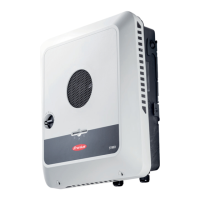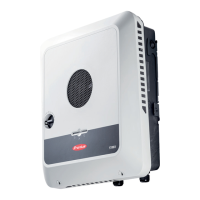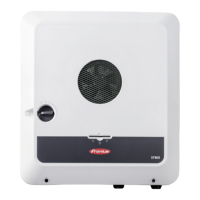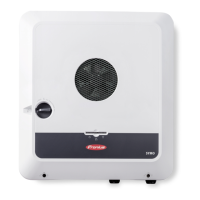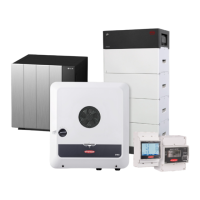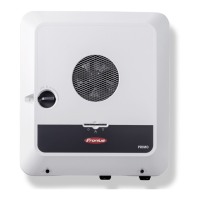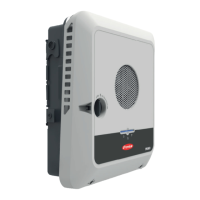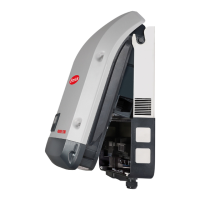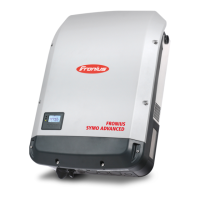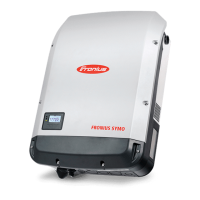Do you have a question about the Fronius Symo GEN24 10.0 Plus and is the answer not in the manual?
Safety regulations, qualified personnel, environmental conditions, and noise emission values.
EMC measures, backup power functions, data protection, copyright, and protective earthing (PE).
Device concept, functional overview, and product variants.
Details on scope of supply, intended use, and improper usage guidelines.
Inverter cooling principles, heat dissipation, and monitoring via Fronius Solar.web.
Symbols and their meanings for various system operating modes.
Descriptions and diagrams of different inverter operating modes with batteries and other components.
States of battery systems like normal operation, energy saving, forced recharging, and deactivated.
Conditions for entering and exiting energy saving mode, including switch-off and switch-on criteria.
Compatibility table for third-party batteries with Fronius Symo GEN24 inverters.
Important notes and general description of the PV Point backup power variant.
Detailed explanation of PV Point voltage, current, and backup power operation.
Essential requirements for using the inverter's full backup power function.
Procedures for switching between grid feed-in and backup power, including cabling variants.
Conditions when backup power and energy saving modes are active for the system.
Device warnings, component compatibility, installation location, and position symbols.
Installing mounting brackets on walls, masts, or rails, and attaching the inverter securely.
Permitted cables, cross-sections, DC/AC cable details, and fuse protection.
Procedures for AC connection to the grid, DC to PV modules, and DC to batteries.
Installing PV Point and Full Backup variants, testing, and specific cabling.
Modbus participants, routing data cables, battery communication, and terminating resistors.
Installing wired shutdown, closing covers, and initial inverter startup.
LED indicators, app-based setup, and web browser setup procedures.
Steps to safely switch off the inverter and restart it.
Accessing the inverter interface, logging in, and changing the display language.
Adding system components like PV generator, battery, meters, and Ohmpilot.
Backup power settings, Demand Response Modes, energy management, and load control.
System name, time synchronization, firmware updates, setup wizard, and factory resets.
License management, technical support access, network setup, Modbus, and Solar API.
Country setup, feed-in limits, dynamic power regulation, and I/O power management.
Performing autotests for Italian standards and notes on grid code settings.
General information, scope, de-energizing, installation, and commissioning of the SPD.
Cleaning procedures, safety precautions, dusty environment operation, and proper disposal.
Warranty information and components for automatic Full Backup power changeover.
Status codes, technical specifications for inverter models, and SPD data.
Various wiring diagrams, circuit diagrams, and inverter physical dimensions.
Safety regulations, qualified personnel, environmental conditions, and noise emission values.
EMC measures, backup power functions, data protection, copyright, and protective earthing (PE).
Device concept, functional overview, and product variants.
Details on scope of supply, intended use, and improper usage guidelines.
Inverter cooling principles, heat dissipation, and monitoring via Fronius Solar.web.
Symbols and their meanings for various system operating modes.
Descriptions and diagrams of different inverter operating modes with batteries and other components.
States of battery systems like normal operation, energy saving, forced recharging, and deactivated.
Conditions for entering and exiting energy saving mode, including switch-off and switch-on criteria.
Compatibility table for third-party batteries with Fronius Symo GEN24 inverters.
Important notes and general description of the PV Point backup power variant.
Detailed explanation of PV Point voltage, current, and backup power operation.
Essential requirements for using the inverter's full backup power function.
Procedures for switching between grid feed-in and backup power, including cabling variants.
Conditions when backup power and energy saving modes are active for the system.
Device warnings, component compatibility, installation location, and position symbols.
Installing mounting brackets on walls, masts, or rails, and attaching the inverter securely.
Permitted cables, cross-sections, DC/AC cable details, and fuse protection.
Procedures for AC connection to the grid, DC to PV modules, and DC to batteries.
Installing PV Point and Full Backup variants, testing, and specific cabling.
Modbus participants, routing data cables, battery communication, and terminating resistors.
Installing wired shutdown, closing covers, and initial inverter startup.
LED indicators, app-based setup, and web browser setup procedures.
Steps to safely switch off the inverter and restart it.
Accessing the inverter interface, logging in, and changing the display language.
Adding system components like PV generator, battery, meters, and Ohmpilot.
Backup power settings, Demand Response Modes, energy management, and load control.
System name, time synchronization, firmware updates, setup wizard, and factory resets.
License management, technical support access, network setup, Modbus, and Solar API.
Country setup, feed-in limits, dynamic power regulation, and I/O power management.
Performing autotests for Italian standards and notes on grid code settings.
General information, scope, de-energizing, installation, and commissioning of the SPD.
Cleaning procedures, safety precautions, dusty environment operation, and proper disposal.
Warranty information and components for automatic Full Backup power changeover.
Status codes, technical specifications for inverter models, and SPD data.
Various wiring diagrams, circuit diagrams, and inverter physical dimensions.
| AC nominal output | 10.0 kW |
|---|---|
| European efficiency | 97.5% |
| Protection class | IP66 |
| Operating temperature range | -25°C to +60°C |
| Integrated data communication | Yes |
| Smart Grid Ready | Yes |
| Max. output power | 10.0 kW |
| Max. DC input voltage | 1000 V |
| Number of MPP trackers | 2 |
| Max. AC output current | 16 A |
| DC connection | MC4 |
| Emergency power | Yes |
| Cooling Method | Active cooling |
| Max. AC apparent power | 10 kVA |
| AC nominal voltage | 400 V |
| AC connection | Screw terminal |
| Max. battery charge/discharge current | 22 A |
| Maximum AC Power | 10 kVA |
| Maximum DC Power | 15, 000 W |
| AC Frequency Range | 50 / 60 Hz |

